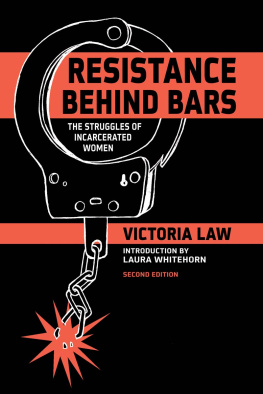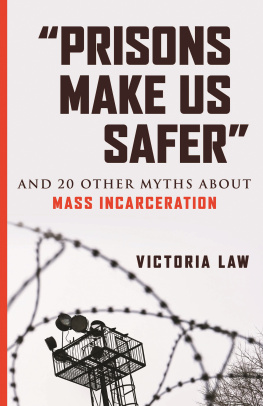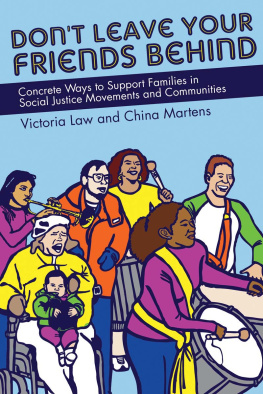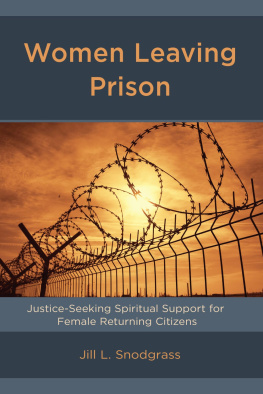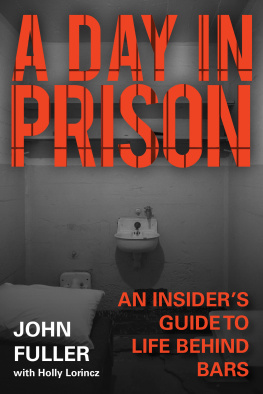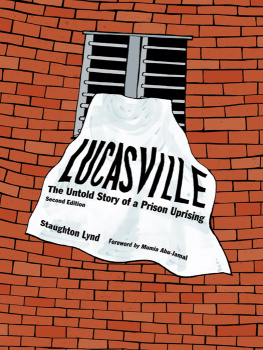Praise for Resistance Behind Bars
This insightful book calls attention to the power, spirit, and courage of women who find themselves behind bars in the era of mass incarceration. By raising up their voices and stories, and by honoring their struggles, this book makes an important contribution to the growing movement to end prisons as we know them.
Michelle Alexander, civil rights lawyer, advocate, legal scholar and author of The New Jim Crow: Mass Incarceration in the Age of Colorblindness
Too often we hear accounts of the atrocities that take place behind prison walls without also hearing about the acts of resistance that inevitably accompany them. Victoria Laws important book illuminates these under reported stories of individual and collective organizing by women in prison and encourages all of us to work in solidarity across prison walls to create a world that no longer includes the prison industrial complex.
Angela Y. Davis, author of Abolition Democracy: Beyond Prison, Torture, and Empire and professor emerita of the History of Consciousness Department, UC Santa Cruz
One of the ironies of the USAs failed experiment in mass incarceration is the relative invisibility of the more than 2.4 million kept behind bars. We sometimes catch fleeting glimpses of the statistics, or of skewed and sordid details via news or reality crime shows, but rarely are the stories of the incarcerated truly told. Nowhere is this truer than with women. Though they remain a relatively small fraction of the incarcerated, the womens prison population has exploded in recent years, and the captured are like their male counterpartsthe young, the poor and people of color. And so too, further marginalized, hidden, and buried alive in the tombs that we call prisons.
Resistance Behind Bars illuminates the stories of the struggles of these women at lastof their efforts to not merely survive the violence and degradation of prison, but to organize at the intersections of race, class and gender, to build a community of resistance amidst the most alienating of circumstances. Victoria Law boldly shines the light and breaks the silence with her exhaustive research, her attention to both the personal and political, and yes, calls uswith the imprisoned women whose stories she shares, always with so much passion and respectto a world without cages.
Nancy A. Heitzeg, professor of sociology and critical studies of race and ethnicity at St. Catherine University and editor of Criminal Injustice at CriticalMassProgresscom
A straightforward examination of the multiple harms that incarcerated women experience and the womens dynamic resistance to everyday systemic indifference and control. Law challenges both prison and patriarchy, each of which would erase womens agency. Resistance Behind Bars refuses to let women prisoners remain unseen and unheard. Instead, it encourages us to think deeply and critically about our own responsibility to redesign a social landscape on which coercion and confinementand especially punishment for profitwill eventually fade away.
Patricia OBrien, associate professor, University of Chicago, and book editor of Affilia: Journal of Women and Social Work
Organizing and community-building are not words one normally associates with womens prisons. Resistance Behind Bars will change that. A thorough and compelling work, Resistance Behind Bars weaves statistics and personal stories to portray the grim realities of life inside womens prisons. By providing examples of how incarcerated women work to change these conditions, it shatters myths of female passivity and preconceptions of what resistance looks like.
Ayelet Waldman, editor of Inside this Place, Not of It: Narratives from Womens Prisons
Victoria Law brings her characteristicand remarkablepassion, personal experience, keen political analysis, courage, and great heart to this new edition of Resistance Behind Bars, an urgently needed and essential resource for all of us who want to learn more about and work to dismantle the structural evil of mass incarceration in the United States. Her intersectional approach, which clearly identifies the intersections of racism, gender violence, and heterosexism, informed by an unshakeable commitment to the human dignity and well-being of the prisoners who inspire her work, make this a unique and invaluable tool for crafting a politics rooted not only in resistance but relentlessly persistent visions of social and economic transformation. The focus on women and gender violence helps breathe new life into work and analysis around prisoner advocacy and prison abolition that too often has been framed through an exclusively male lens. Were all in this struggle togetherbut it is a struggle that demands close attention to the specificities of prisoner experience, rooted in those intersections of race, gender, gender identity/expression, sexuality, and class. Laws book is a brilliant and highly accessible contribution to the burgeoning movement that challenges and proposes to dismantle not only processes of criminalization but the bleak, inhumane nature of the prison industrial complex in its entirety.
Kay Whitlock, coauthor of Queer (In)Justice: The Criminalization of LGBT People in the United States
Resistance offers us a much-needed, much broader and nuanced definition of resistancea womans definition based on the real material conditions of women. I hope that when one reads about the experiences of women prisoners organizing and resistance, the reader, both woman and man, will begin to glimpse the possibilities and necessity of such forms as we continue to struggle for a more just and equal world free from all forms of oppression. If women worldwide are unable to liberate themselves, human liberation will not be possible.
Marilyn Buck, anti-imperialist political prisoner, activist, poet and artist
Finally! A passionately and extensively researched book that recognizes the myriad ways in which women resist in prison, and the many particular obstacles that, at many points, hinder them from rebelling. Even after my own years inside, I learned from this book. Law breaks the AIDS barrier, recognizing and recording prisoner organizing on HIV as resistance against stigma and medical malpractice in the prison system.
Laura Whitehorn, former political prisoner
Constituting 6% of the U.S. prison and jail population, but over 130,000 in number, and growing, women are an all but invisible segment of the prison population. The issues unique to women, and their behind-bars struggle for justice and equality, are even more ignored by mainstream media than that of their male counterparts. Resistance Behind Bars is a long-needed and much awaited look at the struggles, protest and resistance waged by women prisoners. Excellently researched and well documented, this incisive book brings to light aspects of imprisonment unique to women, how the gender-common issues of captivity impact women and the response, protest and resistance to captivity by women. Highly recommended for anyone interested in the modern American gulag.
Paul Wright, former prisoner, founder/editor of Prison Legal News, and coeditor of The Celling of America: An Inside Look at the US Prison Industry, Prison Nation: The Warehousing of Americas Poor and Prison Profiteers: Who Makes Money from Mass Incarceration
Repression tries not only to crush but to quiet. But as Vikki Law shows in this multifaceted book, all that is unseen is not absent. Guided by years of anti-prison organizing and a palpable feminist practice, Law documents the many ways women challenge the twin forces of prison and patriarchy, each trying to render women invisible. In the face of attempts at erasure, women prisoners resist to survive and survive to resist. We would do well to pay attention.

